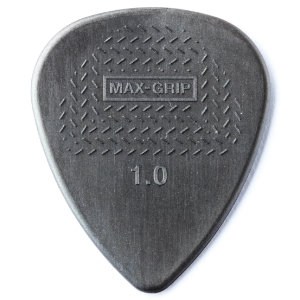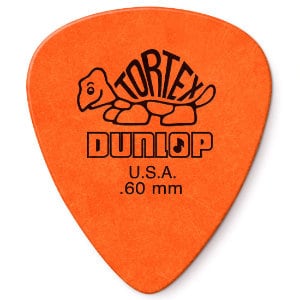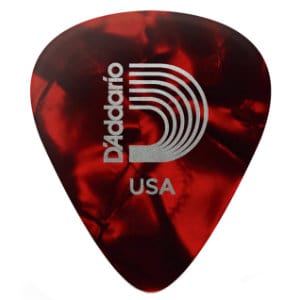A guitar pick is the point of contact between you and your guitar. And it is necessary to find the right guitar pick for yourself. Over the years I have tried different kinds of guitar picks, so, in this article, I am going to write about them for you. I will be covering the following content in this article.
My Top 3 Guitar Picks
1. Dunlop Max-Grip Nylon Standard
Dunlop Jim is one of the leading guitar accessories and gear companies in the world. The max grip pick is made of nylon and has a gripping surface that will prevent it from slipping while you are using it. It is perfect for speed and hard strumming.
2. Dunlop Tortex Standard
The Tortex guitar pick is probably one of the most popular guitars picks on the world. It is known to be used by leading musicians around the world. It is highly durable and has a maximum memory. It produces a bright crisp tone that is perfect whatever you playing a solo or strumming chord near a campfire.
3. D’Addario Pearl Celluloid
Daddario is a well-established guitar accessories manufacturer. Their classic Pearl Cellouid pick is made of celluloid and considered one of the most popular guitars picks material. It creates a natural warm tone.
What Should You Look For In A Guitar Pick?
A guitar pick should have the following features:
- It should come in standard shape for ease of playing
- It should produce warm and bright tones
- It should have maximum memory and minimum wear
- It should be flexible and durable
- It should have an anti-slip surface
Why Do I Recommend Dunlop Max-Grip?
The major reason I use the Dunlop Max-Grip is that of its molded gripping surface. This surface provides a coarse grid that gives a player a non-slip surface. It allows me great precision, durability, and total control. Since it allows great control, it is thus perfect for speed pickers and hard strummers.
If you are still having doubts about this pick you can check the user’s reviews and see for yourself
Pros of Dunlop Max-Grip Nylon Standard
- Nylon guitar picks to produce a very warm sound.
- great for playing solos and strumming
- Max Grip surface gives you excellent pick control in all conditions. Especially when your hands are sweaty
Dunlop Tortex Standard Guitar Pick
The Tortex guitar picks are designed to provide maximum memory and minimum wear to a player. They are available in different shapes and gauges.
They are among the top guitar picks in the market. Many professionals also recommend using it worldwide.
Pros of Dunlop Tortex Standard Guitar Pick
- One of the most used picks in the world, even by professionals
- It provides a great balance of right volume and tonal response.
- It produces a bright tone
- It provides maximum memory and minimum wear.
- It is an affordable guitar pick
D’Addario Pearl Celluloid Guitar Pick
It provides a warm tone. The shape of the pick is perfect for comfortable playing.
Pros of D’Addario Pearl Celluloid Guitar Pick
- It works great for strumming and articulate picking
- It produces bright and warm tones
- It is an affordable guitar pick
The Material Of The Guitar Pick
The material of the pick plays a role in the sound it will produce and the ware it will withstand.
Celluloid
Celluloid picks are not very durable. But they produce a bright and crisp attack. They are very flexible and this is the reason for them to have a “flappy” sound to them.
Nylon
Nylon picks have a bright sound and tend to be pretty flexible. Most of the nylon picks come with a texture on it to help improve the grip. You would not have a problem even when your hands get sweaty.
Acetal
Acetal is durable plastic. They are stiffer than the nylon picks and less stiff than Ultem picks. They tend to have a nice strong attack and are very durable. They are a great choice for people who are starting out.
Ultem
They are super stiff no matter the thickness and they produce a bright tone.
Acrylic
Picks made out of Acrylic have been around since the 80s. They are tough, light and can be molded to almost any thickness. They are usually very clear, so, they look super rad.
The Thickness of A Guitar Pick
The thickness of your guitar pick will play an important role in how bright or warm your guitar will sound. Each guitar pick thickness has its own pros and cons.
Thin
Thin picks usually range anywhere from .40 to .60 mm. They are often bendy and produce light sound. They are best for delicate playing and strumming. You can also find thin guitar picks made out of celluloid. They produce flappy sound and have a bright tone.
Thin picks are not well suited for a lead player as they are going to be too bright for him or her. Thin picks are also flexible and a lead player can lose control due to this. But, if you are starting out then you should opt for thin picks as they offer less resistance.
Medium
Medium guitar picks are going to be in a range from .60 to .80mm. They produce rigid and thicker sound. They also offer a nice high-end and mid-range. Medium thickness picks are the most common and popular among guitarists. They are a great choice if you are going to use them for single notes or for solo playing.
Heavy
Picks that have a thickness ranging in .80 – 1.2 mm are considered heavy. They provide you with ultimate control. They are less flexible and are best suited for rock rhythm playing. They are a great choice for solos and for lead guitarists. But, I recommend not to use them for strumming.
Extra Heavy
The picks that fall in this category have a thickness of 1.2mm or higher. These picks provide super warm, mellow sound. They are usually very popular among bebop and jazz guitarists.
What Style of Guitar Will You be Playing?
The selection of pick also depends on the style of guitar you will be playing.
Lead Guitar
If you are going to be the lead guitarist or planning to play a lot of solos, then I recommend you going for thicker picks. They will produce a crisp sound and offer you great control.
Rhythm Guitar
If you want to play with a band, then you should learn to play great rhythm guitar. If this is the case then I recommended you opting for softer picks. They will allow you to be more flexible with different sorts of rhythm.
Both
Of Course, if you considering playing both lead and rhythm and don’t want to limit yourself to just one role. You can go with the medium thickness which is in the middle of these two roles.
How to Hold a Pick?
- Hold the pick in your strumming hand – Most of the people are comfortable in strumming and plucking guitar strings with their dominant hand. So, hold the guitar pick with your dominant hand.
- Hold Your Pick Between Your Thumb and Index Finger – Try to hold the guitar pick such that you are roughly covering half of it with your finger. Hold the pick firmly, but loose enough to allow the tip of the pick to bend. But no too loose as it may fly out of your hand.
- Find a Grip That is Comfortable for You – you can’t go wrong with the way you hold the pick. But you may want to check the following methods that emphasize control, tone, and comfort.
- “O” Method: place the pick between your thumb and your index finger and form your fingers into an “O” shape. This grip will balance control and tone.
- “Pinch” Method: place the pick between your index finger and your thumb. Try to imagine that you pinching someone. This is a method, used on thinner-gauge picks and strumming.
- “Fist” Method: place the pick between the joint of your thumb and the side of your curled index finger. Forming a fist with your hand. It best used with heavy picks.
- Pivot Your Wrist Toward- Hold the pick in such a way that the tip of the pick rests gently on the string. Make sure that the longer part of the pick is at a 90 angle to the string. The picking process is all about the angle of your wrist. One thing to understand is that when you play the guitar you do not pick with your fingers but with your wrist.
- Brush the Strings – You need to brush the string and not scoop them. But here is a catch. Your brushing should not be so gentle that the sound produced is weak. And at the same time not so rough that you are catching the string on the pick. So, you need to find a middle way.
- Do not impose your will on the instrument rather work with it. Do not hold the pick very hard. Picking requires you to be loose and flexible with your motion. If you hold the pick hard then the sound will be very rigid and off rhythm.
- While strumming you may keep a rigid wrist. But you need to brush even when you strum. These are the things you should keep in mind. At the end of the day, finger and wrist technique are a tool which allows you to play fluidly. When you finally find a method that is comfortable, then you should build on it. Remember everybody is different, so your method can differ. All you need is to find something that is comfortable for you.
If you are interested to know more about holding a pick, then check out my post How To Hold A Guitar Pick – Best Way, Techniques And More
Tips for Picking
Strum with a loose wrist and elbow:
When you begin to play the guitar, it can be very difficult to find the right strumming technique. Something that won’t hurt you after five to ten minutes of strumming. The main thing to remember when you start strumming the guitar is to keep your wrist relaxed. Most of the beginners keep their wrist taut and use their elbow to move back and forth. This is not effective as they miss a lot of notes in succession and the sound produced is not good. All you need to do is to keep your wrist and elbow very relaxed. In the beginning, do not worry if this strumming technique is not producing good sound. It should be you letting your wrist fall across the strings. And once you get comfortable doing this you can move forward.
Note: Thinker picks generate a heavier and more powerful strum. While thinner picks generally make for a gentle and quiet strum.
Single string picking
If you are a beginner, then you should know that each string feels different and it is a challenge to work with all. Moreover, very often simple melodies involve a lot of single-string plucking. So, you work and practice with single strings. Learn the simple melodies as it will give you a lot of confidence. The trick for single-string picking is very simple. You have to make sure that you strike the string with the pick and sharply pull it away from the neck of the guitar. This will help you with not striking any other string accidentally.
Alternate Picking
It allows you to play twice as fast than if you were just down picking or up. You should try to create a flow between your strokes. If you pluck up, then try to strum down and vice versa. This will make your playing very efficient and effective
If you found this article useful, you may want to save this pin below to your Guitar board.

2 thoughts on “Best Guitar Picks & How To Choose The Right Pick For You”
Leave a Reply to Jacob Cancel reply
Recent Posts
When learning new songs have you noticed that some of the chord sequences sound really good? But when you tried to come up with your own chord sequence, or as we call it chord progression, you found...
Some guitarists insist on buying an expensive amplifier with their electric guitar. They assume that this is a must for every type of guitarist out there. However, in some situations, this isn’t...





Excellent job Jacob! Thanks for the clear concise information!
Thank you!
No problem!